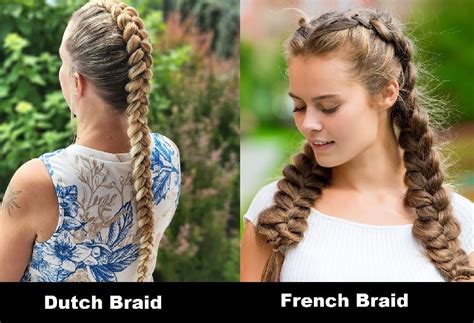Introduction

Braiding has been a timeless hair styling technique for centuries, with countless variations and intricate patterns to choose from. Two of the most popular and iconic braids are the Dutch braid and the French braid. Each with its unique charm and appeal, these braids have captivated hair enthusiasts around the world. In this comprehensive guide, we’ll delve into the fascinating world of Dutch and French braids, exploring their similarities, differences, and practical applications.
Similarities
- Underlying Structure: Both Dutch and French braids share a fundamental structure, consisting of three strands of hair interwoven in an intricate pattern.
- Braiding Process: The braiding technique involves crossing the outer strands over the middle strand and the middle strand under the outer strands, creating a continuous and secure weave.
- Versatile Styling: Both Dutch and French braids can be incorporated into a wide range of hairstyles, from elegant updos to playful ponytails, adding an element of sophistication and flair.
Differences
- Direction of Braiding: The primary difference between Dutch and French braids lies in the direction of braiding. Dutch braids are braided underhand, with the strands crossing under each other, while French braids are braided overhand, with the strands crossing over each other.
- Appearance: Dutch braids are characterized by their raised or “lifted” appearance, creating a thicker and more voluminous braid compared to French braids.
- Texture and Style: Dutch braids tend to be tighter and more textured than French braids, resulting in a more rugged and athletic look. French braids, on the other hand, are smoother and more refined, exuding a graceful and elegant charm.
Historical Context and Cultural Significance
Dutch Braid:
- Originated in the Netherlands in the 16th century
- Associated with the Dutch national costume and traditional folklore
- Often worn by Dutch women as a symbol of cultural identity
French Braid:
- Originated in France in the 18th century
- Considered a classic and sophisticated hairstyle in Western cultures
- Frequently featured in royal portraits and high-society events
Applications and Practicality
Dutch Braid:
- Athletic Activities: Ideal for sports and physical activities due to its secure hold and ability to withstand movement
- Volume and Texture Enhancement: Adds volume and texture to thin or flat hair, creating a fuller and more dramatic appearance
- Everyday Versatility: Can be worn in a variety of casual and semi-formal settings, adding a touch of interest and style
French Braid:
- Formal Occasions: Perfect for weddings, proms, and other special events, providing a polished and elegant touch
- Hair Growth Protection: Protects long or damaged hair from breakage and tangles by securing it in a neat and tidy braid
- Convenience and Functionality: Can be worn for extended periods of time without discomfort or strain, making it practical for busy individuals
Step-by-Step Tutorials
Dutch Braid:
- Start with slightly dampened hair
- Divide hair into three equal strands
- Cross the right strand over the middle strand, then the left strand over the middle strand (underhand)
- Add a small section of hair from the left side to the left strand, then cross it under the middle strand
- Add a section of hair from the right side to the right strand, then cross it under the middle strand
- Continue the braiding process, alternating between left and right sections, until the braid is complete
- Secure the end of the braid with an elastic band
French Braid:
- Start with slightly dampened hair
- Divide hair into three equal strands
- Cross the right strand over the middle strand, then the left strand over the middle strand (overhand)
- Add a small section of hair from the right side to the right strand, then cross it over the middle strand
- Add a section of hair from the left side to the left strand, then cross it over the middle strand
- Continue the braiding process, alternating between right and left sections, until the braid is complete
- Secure the end of the braid with an elastic band
Tips and Tricks
- Use a hairspray or mousse to help create a smooth and secure braid
- Experiment with different braiding techniques such as fishtail, waterfall, and crown braids
- Accessorize your braids with hair clips, ribbons, or flowers
- Create a half-up or half-down hairstyle by braiding the top or bottom section of hair
Helpful Tables
Braiding Comparison Table
| Feature | Dutch Braid | French Braid |
|---|---|---|
| Direction of Braiding | Underhand | Overhand |
| Appearance | Raised, voluminous | Smooth, elegant |
| Texture | Tight, textured | Loose, flowing |
Practical Applications Table
| Activity | Dutch Braid | French Braid |
|---|---|---|
| Sports | Yes | No |
| Volume Enhancement | Yes | No |
| Everyday Versatility | Yes | Yes |
| Formal Occasions | No | Yes |
| Hair Growth Protection | No | Yes |
Styling Inspiration Table
| Hairstyle | Dutch Braid | French Braid |
|---|---|---|
| Half-Up, Half-Down | Yes | Yes |
| Crown Braid | Yes | No |
| Waterfall Braid | No | Yes |
| Fishtail Braid | Yes | Yes |
Hair Type Considerations
| Hair Type | Dutch Braid | French Braid |
|---|---|---|
| Thick Hair | Yes | Yes |
| Thin Hair | Yes | Yes |
| Curly Hair | Yes | No |
| Straight Hair | Yes | Yes |
Conclusion
Whether you prefer the rugged and voluminous texture of a Dutch braid or the polished and elegant charm of a French braid, both hairstyles offer a timeless and versatile way to enhance your hair’s beauty and style. By understanding their unique characteristics, practical applications, and step-by-step techniques, you can confidently create stunning braids that will turn heads and leave a lasting impression. Embrace the art of braiding and let your creativity shine through.
